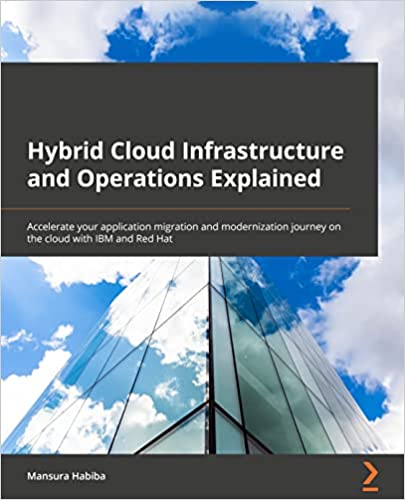Mansura is the author of ‘Modernizing Hybrid Cloud Infrastructure‘. We got the chance to sit down with her and find out more about her experience of writing with Packt.
Q. What is/are your specialist tech area(s)?
Mansura: Application development and modernization, Cloud operations, Artificial Intelligence,
Q: How did you become an author for Packt? Tell us about your journey. What was your motivation for writing this book?
Mansura: I fell in love with developing software back in 2000. Over my career, I learned a lot from my mentors, colleagues and community. I faced a massive change during my career as I started cloud application development for IBM Watson products. All of a sudden, I had more control over infrastructure also more responsibilities. Application architecture started to become more cloud-native rather than monolithic. The legacy best practices were no longer best practices. The scaling for applications started to grow massively. As an application developer, I had to adopt a new practice, methods and way of working, which I enjoyed a lot. Fast forward to 2020, I started work as a cloud infrastructure architect for application modernization and migration project. I have a different problem to solve now: using cloud services and infrastructure effectively. I realized that having a stable and resilient platform is a shared responsibility among decision-makers, architects, developers, operation engineers and other platform stakeholders. Cloud can bring benefits if only it is used with best practices and proper plan and design. I learned different methods, practices, processes and operations to ensure efficient cloud infrastructure development and management. <Book Name : Modernizing Hybrid Cloud Infrastructure> is my attempt to help developers, architects, CxOs understand high-level concepts of cloud nativeness, best practices, development methods, operations and other aspects of cloud-native application development on hybrid cloud.
Q: What kind of research did you do, and how long did you spend researching before beginning the book?
Mansura: This book combines best practices, methods and processes used in industry. I have collected different industry use cases that I have worked on as a Platform architect and technical lead for the applications development team at IBM. These use cases helped me understand the real-world problems and industry-specific patterns for application modernization, migration and cloud operations. As these are real-world problems, I got a good data set for the functional and non-functional requirements for different aspects of cloud infrastructure implementation, cloud-native application development and cloud operations. Using this primary set of data as the baseline, I started to write this book
Q: Did you face any challenges during the writing process? How did you overcome them?
Mansura: As this is my first book, there were challenges that I had to overcome. Sometimes I had to keep up with the deadline, and sometimes I messed up the initial plan for the content of chapters. However, I overcame them smoothly as I had a fantastic team supporting me. I learned a lot during my first book, which will be very helpful if I feel like writing again.
Q: Why should readers choose this book over others already on the market? How would you differentiate your book from its competition?
Mansura: This book is mainly based on real-world use cases from different industries. Therefore, they talk about functional and non-functional requirements for different aspects of cloud-native applications development and operations. For example, compute, storage, network, security, resiliency, operations, development practice, etc.
This book discusses architecture decisions, development methods and
best practices for different real-world use cases and provides an end-to-end solution for a different common problem.
This book discusses some basic concepts from a hybrid cloud point of view. As only knowing use of different cloud services from different. Cloud providers are not enough to ensure the efficient implementation of cloud infrastructure without knowing the concepts and paractices.
As the world is choosing a hybrid cloud strategy as the standard strategy for different industries to leverage the strength of different cloud providers to its best extent, this book is a great companion to explore different aspects of hybrid cloud. Instead of focusing on a single cloud like other available books in the market, this book discusses the problem in hybrid or multi-cloud infrastructure.
Cloud operations are another essential part of cloud implementation of business objectives for different industries. The cloud is not continuously managed and operated and can not bring the expected outcome for the business. This book also discusses different aspects of cloud operations, such as FinOPs, problem management, incident management, etc.
Q: What advice would you give to readers learning tech? Do you have any top tips?
Mansura: Never lose your appetite to learn new or old technology with new aspects. – Make learning a daily habit – Improve hands-on practice with conceptual background. Hands-on experience is not enough without proper conceptual understanding, similarly concepts only is not a complete learning experience for any technology
Q. What are the key takeaways you want readers to come away from the book with?
Mansura: Understand the cloud infrastructure and its aspects ; – Understand different drivers of cloud adoption in the industry – Understand the hybrid cloud infrastructure – Adopt best practices for cloud native application development and cloud operations
Q. Do you have a blog that readers can follow?
Mansura: https://medium.com/@mansurahabiba
Q. Can you share any blogs, websites and forums to help readers gain a holistic view of the tech they are learning?
Mansura: https://www.ibm.com/cloud/architecture/
Q. What are your favorite tech journals? How do you keep yourself up to date on tech?
Mansura: MIT Technology Review – Neurocomputing – The Gurdian
Q. How would you describe your author journey with Packt? Would you recommend Packt to aspiring authors?
Mansura: I was hesitant to start the journey as an author. I had no experience writing a book before. I wrote the journal and blogs, but this is my first book of mine. After submitting my proposal to Packt, I was confused and uncomfortable and most importantly, I had to proper plan about how to execute my aspiration as an author in reality. However, from the first day, the Packt team was very kind, understanding and organized, which changed my entire feelings; me being confused suddenly made me excited. The packt team helped to plan my journey efficiently and then execute the plan as we moved forward. I am immensely grateful to each team from packt who helped me in my journey. there is no doubt that I will recommend Packt to aspiring authors
Q. How did you organize, plan, and prioritize your work and write the book?
Mansura: Planning before writing is something new I have done while writing this book. At the very beginning, I planned a story that I wished to depict in 10 chapters in the book. Each of the chapters was a block for the story. They were independent but connected. The Packt team helped establish this story and plan it accordingly. I found planning was 30% work for the complete writing. Once I had my storyline laid out, I did some research. I identified relevant real-world use cases, I read several books on the similar topic and tried to understand their motivation and the difference in my motivation.
My motivation for this book was mainly to discuss typical and standard industry patterns for cloud adoption. These use cases were the overall priority driver for this book. I structured the chapters as different building blocks of these standard use cases. Therefore, there was no confusion or back-and-forth rewrite as the skeleton of my book was predefined and influenced by the backbone use cases. My writing went too deep in technical or conceptual based on where these use cases took me while writing the chapters. I prioritized the use cases and requirements that are highly prioritized in the industries,
Q. What is that one writing tip that you found most crucial and would like to share with aspiring authors?
Mansura: Plan before writing ; Planning is the 45% job done for any piece of writings such as blog, books and others.
Q. Do you belong to any tech community groups?
Mansura:
1. https://www.linkedin.com/groups/4110054
2. https://www.linkedin.com/groups/3679348
3. https://www.linkedin.com/groups/54723
4. https://www.meetup.com/dublin-node-js-meetup
5. https://www.meetup.com/pyladiesdublin/
6. https://www.womeninai.co/
You can find Mansura’s book on Amazon by following this link









